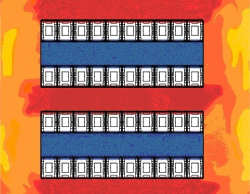Only just a bit? Efficiency, performance per watt, dba. I suspected this design would be a game changer from a thermodynamics point of view all along and I'm even more convinced after having one here.
Many ultra top end power users like yourself and tutor have outgrown any Mac Pro apple could have possibly released, but I reckon within 5 years you two will be considering options for mobo, CPU and GPU with this thermal core ripped off by the market at its heart. Probably expanded to 6, 9, dozen, more slots around the core to host your cards. If you scale up the kind of savings this design permits to one of your top end rigs or right past you to the large render farms and even supercomputers the market will no doubt head in this direction.
And this little tube will be the daddy of all of them!
The thermal core is not some kind of "game changer," especially in terms of thermodynamics. There are really important reasons why you wouldn't want it in a multi-GPU rig like Aiden describes in such a configuration:
- Much more difficult to replace a part in the event of failure (this problem isn't going anywhere, you need direct contact with the GPU/CPU and heat sink)
- Extremely limited upgrade options (Due to proprietary design of the cards)
- Extremely limited replacement options (Due to proprietary design)
- no SLI (or no Xfire, depending on your proprietary cabling)
Moreover, this is not any more efficient in terms of actual
cooling, just in terms of
space. All the "thermal core" (can we just call it a "shared heat sink" ? ) does is take excess thermal capacity of the heat sink. When all three of the main components in the nMP are on maximum load, we've already seen what happens: the CPU temp on the nMP ramps up to 90C and throttles which is totally unacceptable -- can't even handle 450Watts!
The design's fine for
this under-clocked heavily binned/skimmed hardware. However, throw in something like what Aiden is talking about -- Four Quadros and two CPUs -- and you're talking about a fan/heat sink combination 5 times as big and twice as loud. It'll look like a shop-vac.
Introducing: The HP-TUBE - 4 NVidia Quadros, 24 Cores, totally pointless
Sure, NVidia will make a more efficient chip some day. Then they'll clock it up some more and take up the slack, not downclock it like Apple's done so it can fit in a smaller box.
The only thing that impresses me about the nMP is the binning that AMD has done with the chips on the D700. Instead of up-clocking a more efficiently binned chip, they down-clocked it. Even though they're pretty darn under-clocked, the low wattage is very impressive, but this is no miracle -- we'd probably be seeing this all the time, if people cared that much about wattage Vs Price-point. Wait a minute, we
do see this all the time--these chips are used in these machines called
laptops.






